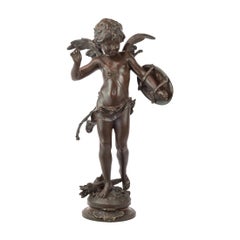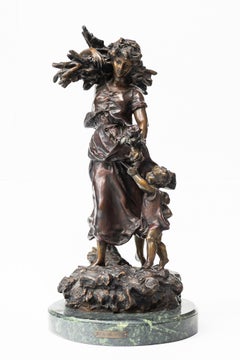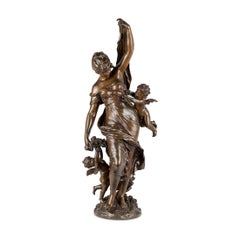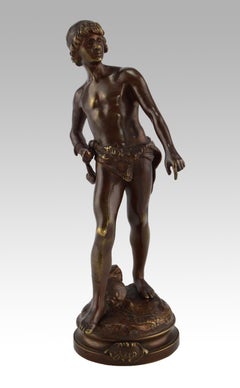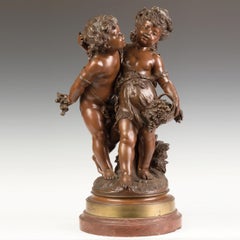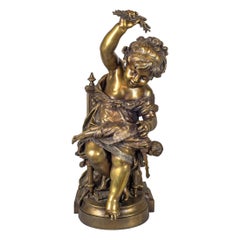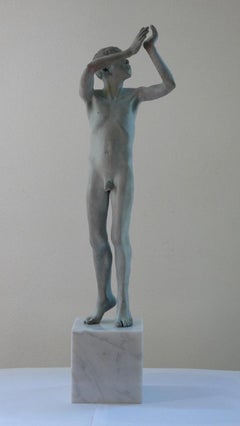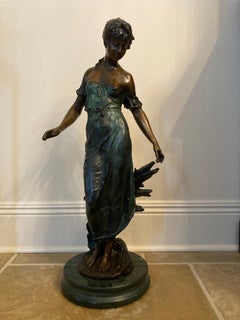Louis Auguste Moreau Figurative Sculptures
French, 1855-1919
Moreau was born in Dijon in 1855, he studied with his father and also under Aimé Millet, Augustin Drumont and Jean Thomas. Moreau's style was realistic and graceful, revealing his relation to the other members of the Moreau dynasty. The similitude of names sometimes provokes confusion. Louis August Moreau was the son of Auguste Moreau and nephew to two other celebrated French sculptors Mathurin and Hyppolyte-François, he learned sculpture under their influence as well as at the école des beaux arts in Paris. He had a brother Hyppolyte who was also sculptors. Thus making a celebrated dynasty of French sculptors creating numerous models that can now be found in museums throughout the world. Bronze sculptures by Louis August Moreau are prime examples of the Art Nouveau style. He worked in France during the turn of the century and regularly exhibited his bronze sculptures. Moreau's bronze sculptures, such as Curiese, have inspired other sculptures to create in a similar style. (Haynes Fine Art)to
2
3
3
Overall Width
to
Overall Height
to
7
1
8
8
6
6
5
4
2
1
1
8
8
3
3
9
125
100
96
92
7
1
Artist: Louis Auguste Moreau
Alerte
By Louis Auguste Moreau
Located in New York, NY
AUGUSTE MOREAU
French, (1834-1917)
Alerte
Patinated bronze; Signed ‘Aug Moreau’ and title ‘Alerte’ on base
22 x 14 1/2 inches
Notes:
Cupid's figure is standing with a bow on hi...
Category
Late 19th Century Louis Auguste Moreau Figurative Sculptures
Materials
Bronze
"Mother and Child" Art Nouveau Bronze Sculpture Woman Carrying Harvest Green
By Louis Auguste Moreau
Located in Austin, TX
20 inches tall x 11 inches wide at base.
Signed.
Numbered 6/100
A cast bronze sculpture that depicts an adult female, rural worker, mid-stride, holding a large bundle of wood on her...
Category
Early 20th Century Art Nouveau Louis Auguste Moreau Figurative Sculptures
Materials
Marble, Bronze
Figural Group of Venus Flanked by Putti
By Louis Auguste Moreau
Located in New York, NY
LOUIS AUGUSTE MOREAU
French, (1834-1917)
Figural Group of Venus Flanked by Putti
Patinated bronze; Signed ‘Ate Moreau’
28 in. x 11 in x 8 inches
Notes:
Having a deep brown...
Category
Late 19th Century Louis Auguste Moreau Figurative Sculptures
Materials
Bronze
19th Century bronze sculpture of David
By Louis Auguste Moreau
Located in Nr Broadway, Worcestershire
Louis Auguste Moreau
French, (1855-1919)
David
Bronze, signed
Height: 7.5 inches
Width: 3.25 inches
Depth: 3 inches
Louis Auguste Moreau was born in Dijon, France in 1855 into a fam...
Category
19th Century Victorian Louis Auguste Moreau Figurative Sculptures
Materials
Bronze
Children Picking Grapes
By Louis Auguste Moreau
Located in New York, NY
LOUIS AUGUSTE MOREAU
French, (1834-1917)
Children Picking Grapes
Patinated Bronze; Signed Aug Moreau
20 1/2 x 12 x 9 inches
Category
Late 19th Century Louis Auguste Moreau Figurative Sculptures
Materials
Marble, Bronze
French Patinated Bronze Sculpture of a Girl with Doll by Auguste Moreau
By Louis Auguste Moreau
Located in New York, NY
LOUIS AUGUSTE MOREAU (French, 1834-1917)
Signed ‘auguste moreau’
19th Century
24 1/2 in. x 11 in. x 11 in.
Category
19th Century Louis Auguste Moreau Figurative Sculptures
Materials
Bronze
Auguste Moreau Bronze Sculpture of Maiden Seated beside a Peacock .
By Louis Auguste Moreau
Located in New York, NY
A Fine French Patinated Bronze Figure of Young Maiden sitting beside a Peacock surmounted atop a rouge marble plinth by Auguste Moreau.
Perfect size for a desk or dresser, or mantle ornament...
Category
19th Century Louis Auguste Moreau Figurative Sculptures
Materials
Marble, Bronze
Grecian Mother and Two Children
By Louis Auguste Moreau
Located in New York, NY
LOUIS AUGUSTE MOREAU
French, (1834-1917)
Grecian Mother and Two Children
Patinated bronze; Signed “MOREAU”.
22 x 25 inches
Category
Late 19th Century Louis Auguste Moreau Figurative Sculptures
Materials
Bronze
Related Items
"Vigils Echo 4" Contemporary Nude Sculpture of a Woman with Bunny Mask
By Rachel Ann Stevenson
Located in Utrecht, NL
The mysterious artworks by Rachel Ann Stevenson invite you into a dream world. Rachel Ann sees artists as day dreamers who can show the impossible...
Category
2010s Contemporary Louis Auguste Moreau Figurative Sculptures
Materials
Bronze
$7,800
H 20.48 in W 3.94 in D 4.73 in
Gallulus Bronze Sculpture Nude Boy Male Figure Green Patina Marble Stone
By Wim van der Kant
Located in Utrecht, NL
Gallulus Bronze Sculpture Nude Boy Male Figure Green Patina Marble Stone
Wim van der Kant (1949, Kampen) is a selftaught artist. Next to his busy profess...
Category
21st Century and Contemporary Contemporary Louis Auguste Moreau Figurative Sculptures
Materials
Marble, Bronze
$9,580
H 16.54 in W 7.88 in
Bufo Contemporary Bronze Sculpture Nude Boy Marble Stone Male Figure
By Wim van der Kant
Located in Utrecht, NL
Bufo Contemporary Bronze Sculpture Nude Boy Marble Stone Male Figure
Wim van der Kant (1949, Kampen) is a selftaught artist. Next to his busy profession as a teacher at a high school, he intensively practises his profession as a sculptor. Only when his work would measure up to his own standards, he decided to present it to the rest of the world. In 1995, he exhibited for the first time with Morren Galleries. Van der Kant desires to sculpt young people who still stand uninhibited and curiously in life. The reason he chooses to sculpt boys is, because he is one himself, this way the subject is closer to him. The anatomy of his figures testify of perfectionism. Van der Kant's subjects show similarities with the sculptures from the Greek and Roman antiquity...
Category
21st Century and Contemporary Contemporary Louis Auguste Moreau Figurative Sculptures
Materials
Marble, Bronze
$10,681
H 12.21 in W 7.88 in
Tolla Inbar, Circle of Life, Bronze sculpture
By Tolla Inbar
Located in Tel Aviv, IL
Tolla Inbar, Circle of Life, bronze sculpture, International artist, Israeli artist, Figurative sculpture, art
Category
Early 2000s Contemporary Louis Auguste Moreau Figurative Sculptures
Materials
Bronze
$16,000
H 39.37 in W 39.37 in D 9.84 in
Agathon Leonard Silvered Bronze Of Marguerite
By Agathon Léonard
Located in Dallas, TX
Agathon Leonard (French, 1841 - 1923) Art Nouveau Silvered Bronze
A French Art Nouveau gilt bronze sculpture, "Marguerite", by Agathon Léonard of Margeruite, placing a flower in her...
Category
1890s Art Nouveau Louis Auguste Moreau Figurative Sculptures
Materials
Bronze
Pear With Leaf Patinated Bronze Sculpture
By Randi Grantham
Located in Lake Worth Beach, FL
Pear with a leaf.
Artist signed, patinated bronze, on black marble base 8"x8"
Randi Grantham was born and raised in Las Vegas, Nevada and now lives in South Florida. He is a self ta...
Category
2010s Contemporary Louis Auguste Moreau Figurative Sculptures
Materials
Marble, Bronze
Seating Group Green Velvet
Located in Zug, CH
CARLO RAMPAZZI (b. 1949)
Seating Group
2007
Sofa covered in green mohair velvet, supported by a bronze structure slide; Armchairs with shell artisan decoration, with green Haute Cout...
Category
21st Century and Contemporary Contemporary Louis Auguste Moreau Figurative Sculptures
Materials
Bronze
Abstract Bronze Sculpture, Prince Monyo
Located in Palm Desert, CA
This is a striking abstract bronze sculpture by Prince Mono. Utilizing the lost wax process, the piece is polished bronze. The piece has its own square base which is signed, "Monyo"....
Category
1970s Louis Auguste Moreau Figurative Sculptures
Materials
Bronze
Cast Bronze Brutalist Warrior Bust
Located in Palm Desert, CA
A wonderful stylized bust of a warrior. It appears that a dragon like creature sits on his helmet, rather is his helmet. You can't help but draw similarities to Game of Thrones. This...
Category
1960s Louis Auguste Moreau Figurative Sculptures
Materials
Marble, Bronze
Cast Bronze Lifesize Gorilla
Located in Palm Desert, CA
This bronze gorilla sits astutely with it's left hand out and it's right arm relaxed to the ground. The glass eyes are black and reflect surrounding light and give this fella a compa...
Category
Late 20th Century Louis Auguste Moreau Figurative Sculptures
Materials
Bronze
Patinated Bronze Sculpture of a Kneeling Woman by Guy Charles Revol '1912-1991'
By Guy Charles Revol
Located in Palm Desert, CA
This is an exquisite bronze sculpture depicting a kneeling woman by Guy Charles Revol. Possibly another interpretation of Venus Kneeling, this young woman is kneeling on her left kne...
Category
1940s Louis Auguste Moreau Figurative Sculptures
Materials
Bronze
$1,600
H 13.5 in W 7 in D 5.5 in
Bronze Sculpture, Il Cavalino, by Barbara Beretich '1936-2018'
By Barbara Beretich
Located in Palm Desert, CA
This is a signed bronze sculpture of a horse entitled, Il Cavalino, by Barbara Beretich. This is a lost wax cast and the piece is from her home gallery as seen in picture #8. During ...
Category
1960s Louis Auguste Moreau Figurative Sculptures
Materials
Bronze
$8,500
H 29 in W 26 in D 10 in
Previously Available Items
"Elegance" - Early 20th Century Antique Bronze Woman Sculpture
By Louis Auguste Moreau
Located in New Orleans, LA
An exquisite bronze by French sculptor Auguste Moreau, a very highly regarded artist who showed regularly in the Paris Salon shows in the early 20th century. He often depicted cherub...
Category
Early 20th Century Louis Auguste Moreau Figurative Sculptures
Materials
Bronze
Louis Auguste Moreau figurative sculptures for sale on 1stDibs.
Find a wide variety of authentic Louis Auguste Moreau figurative sculptures available for sale on 1stDibs. You can also browse by medium to find art by Louis Auguste Moreau in bronze, metal, marble and more. Not every interior allows for large Louis Auguste Moreau figurative sculptures, so small editions measuring 4 inches across are available. Customers who are interested in this artist might also find the work of and Albert-Ernest Carrier-Belleuse. Louis Auguste Moreau figurative sculptures prices can differ depending upon medium, time period and other attributes. On 1stDibs, the price for these items starts at $1,580 and tops out at $12,000, while the average work can sell for $8,500.
